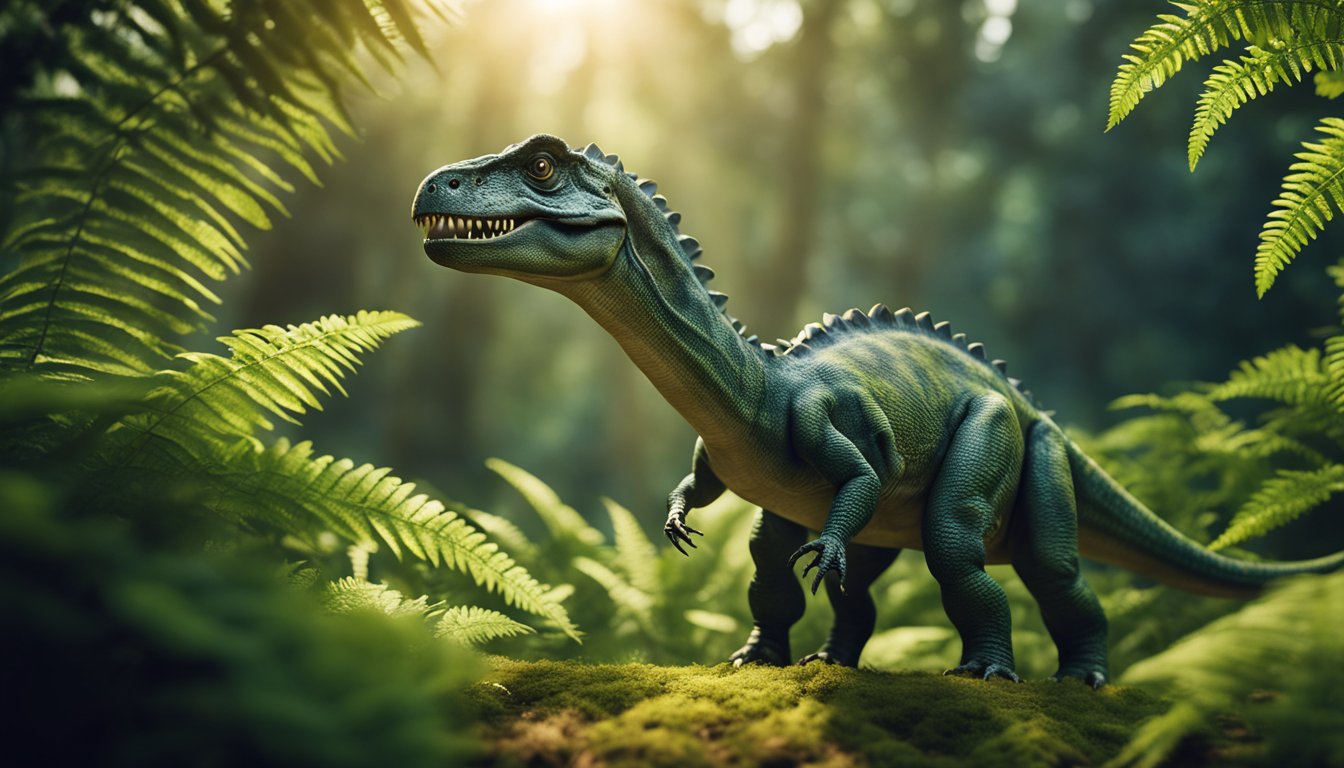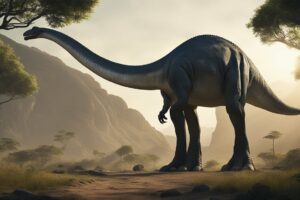Estemmenosuchus is a prehistoric creature that lived during the Permian period, approximately 255 million years ago.
This fascinating animal was a therapsid, which is a group of mammal-like reptiles that roamed the Earth before the dinosaurs.
Estemmenosuchus was known for its bizarre horns that projected both upwards and outwards, possibly for intra-specific display.

The creature had five large teeth on the maxillae, a short canine, and at least twenty small and uniform post-canines.
Estemmenosuchus was a genus of omnivorous reptiles that lived in the Perm region of Russia.
Fossils of two species of Estemmenosuchus have been found near Perm, Russia, Estemmenosuchus uralensis and Estemmenosuchus mirabilis.
Both species differ in size, shape of the skull, and shape of the horns.
Estemmenosuchus, also known as the “crowned crocodile,” was a fascinating creature that has captured the attention of scientists and enthusiasts alike.
Its unique horns make it stand out among other prehistoric animals and provide insight into the behavior and appearance of this ancient species.
In this article, we will explore the world of Estemmenosuchus and learn more about its fascinating characteristics.
Unraveling the Mystery of Estemmenosuchus
Estemmenosuchus is a prehistoric creature that lived approximately 255 million years ago during the Late Permian Period.
It was a therapsid, which means it was a mammal-like reptile that is now extinct.
Estemmenosuchus was first discovered in Russia, specifically in the Perm region of the Urals, during the middle of the 20th century by scientists.
Distinctive Skull and Horns
Estemmenosuchus is known for its distinctive skull and horns.
The name Estemmenosuchus means “Crowned Crocodile” in Greek, and it’s easy to see why.
Its skull was broad and flat, and it had a pair of bony head crests that resembled horns.
The horns were made of bone and were probably used for intra-specific behavior. There is great individual variation in the horns.
Estemmenosuchus had a set of teeth that were adapted for an omnivorous diet.
Its teeth were small and sharp, and they were perfect for tearing apart plants and small prey.
Its large size and bulk have also led scientists to suggest that Estemmenosuchus was gigantothermic.
This is where an animal has a low surface area to body mass ratio, resulting in the outer tissue layers insulating the inner layers.
This increases the base temperature of the animal, giving it a metabolism close to a warm-blooded animal.
Habitat and Discovery
Estemmenosuchus lived in the Permian swamps of Russia. The Permian period was a time when the Earth was very different from what it is today.
The continents were all joined together in a supercontinent called Pangaea, and the climate was much warmer and more humid than it is today.
The Permian swamps were filled with all kinds of bizarre and fascinating creatures, including Estemmenosuchus.
Fossils of two species of Estemmenosuchus have been found in the Perm region of Russia.
These species are Estemmenosuchus Uralensis and Estemmenosuchus Mirabilis.
Scientists have been able to learn a lot about Estemmenosuchus from these fossils, including its size, diet, and habitat.
Estemmenosuchus was a fascinating creature that roamed the Earth millions of years ago.
Its distinctive skull and horns make it one of the most recognizable prehistoric creatures.
Scientists continue to study Estemmenosuchus and other prehistoric creatures to learn more about the history of life on Earth.
Lifestyle of a Prehistoric Enigma

Estemmenosuchus, the prehistoric creature with bizarre horns, belongs to the group of therapsids, a suborder of synapsids that includes mammals and their extinct relatives.
This enigmatic creature lived during the Late Permian period, approximately 255 million years ago, in what is now Russia.
Estemmenosuchus was a member of the family Estemmenosuchidae, which includes other herbivorous therapsids with horn-like structures on their skulls.
Dietary Habits
As with many therapsids, the exact dietary habits of Estemmenosuchus are still a subject of debate among paleontologists.
Some have pointed to the sharp canines and incisors and declared Estemmenosuchus to be a carnivore.
However, many herbivorous therapsids still have carnivore-like teeth, and the sheer bulk and size of the body suggest that Estemmenosuchus was primarily a herbivore.
Estemmenosuchus had a sprawling posture and a complex digestive system that allowed it to extract nutrients from tough plant material.
Physical Characteristics
Estemmenosuchus was a large, bulky animal, with a body length of up to 3 meters and a weight of up to 500 kg.
It had a sprawling posture with legs that extended out to the sides, similar to modern reptiles.
Estemmenosuchus had a thick, scaly skin with evidence of fur-like structures in some specimens.
It also had two large, horn-like structures on its skull, which were likely used for display or defense against predators.
Skin impressions suggest that Estemmenosuchus had a pattern of small, diamond-shaped scales covering its body.
Despite its bizarre appearance, Estemmenosuchus was a successful and adaptable creature that survived for millions of years in a changing environment.
Its unique combination of features, including its herbivorous diet, sprawling posture, and horn-like structures, make it a fascinating subject for paleontologists and a source of wonder for anyone interested in the natural world.
The Evolutionary Significance of Estemmenosuchus

A Link to Ancient Relatives
Estemmenosuchus, a herbivorous therapsid, lived during the late Permian period, which lasted from 298.9 to 252.2 million years ago.
Estemmenosuchus is classified as a member of the Anomodontia, a group of synapsid therapsids that evolved from carnivorous ancestors and diversified into herbivorous forms.
The Anomodontia were a dominant group of herbivorous therapsids during the Permian period, and they played a crucial role in the evolution of terrestrial ecosystems.
Estemmenosuchus belongs to a family of therapsids called Estemmenosuchidae, which includes other bizarre-looking species such as Deuterosaurus and Ulemosaurus.
Estemmenosuchids are characterized by their unusual cranial ornamentation, including bony crests, flanges, and horns.
These structures are thought to have been used for display, thermoregulation, and combat.
Estemmenosuchus is also related to other primitive theriodonts from the Late Permian, such as Tapinocephalia and Anteosauria.
These groups of theriodonts were part of the Tetrapods from the East European Placket—Late Paleozoic Natural Territorial Complex, which was a unique biogeographic region that included parts of modern-day Russia, Ukraine, and Kazakhstan.
Comparisons with Contemporary Fauna
Estemmenosuchus was a contemporary of some of the earliest dinosaurs, which evolved during the Late Permian and became dominant during the Triassic period.
Although Estemmenosuchus and dinosaurs were both part of the same group of reptiles called the Archosauriformes, they were not closely related.
Estemmenosuchus was a therapsid, while dinosaurs were diapsids.
Estemmenosuchus and other herbivorous therapsids were important components of the Late Permian terrestrial ecosystems.
They were the primary consumers of plants and played a crucial role in shaping the vegetation communities.
The evolution of herbivory in therapsids was a significant event in the history of life on Earth, as it led to the diversification of plant-eating tetrapods, including mammals.
In conclusion, Estemmenosuchus and other herbivorous therapsids were an important part of the Permian ecosystems, and their evolution had a significant impact on the history of life on Earth.
The bizarre cranial ornamentation of Estemmenosuchus and other estemmenosuchids is a testament to the diversity of form that evolution can produce.
Frequently Asked Questions

What kind of habitat did Estemmenosuchus live in?
Estemmenosuchus lived during the Late Permian period, approximately 255 million years ago. These prehistoric creatures were found in what is now Russia.
Scientists believe that Estemmenosuchus lived in a tropical environment, possibly near swamps or other wetlands.
How did Estemmenosuchus use its horns?
Estemmenosuchus is known for its bizarre horns, which were made of bone.
These horns were likely used for intra-specific behavior, meaning that they were used to communicate with other members of the same species.
Scientists believe that Estemmenosuchus may have used its horns for display during mating season or to establish dominance within a group.
Can you describe the physical appearance of Estemmenosuchus?
Estemmenosuchus was a mammal-like reptile that was about the size of a modern-day rhinoceros. It had a large, bulky body and short legs.
Its most distinctive feature was its horns, which were made of bone and protruded from the top of its skull.
Estemmenosuchus had a long snout with sharp teeth that were possibly used for eating plants and small animals.
What are some of the closest relatives to Estemmenosuchus in the prehistoric world?
Estemmenosuchus belonged to a group of animals called therapsids, which were mammal-like reptiles that lived during the Permian and Triassic periods.
Some of the closest relatives to Estemmenosuchus include other members of the Estemmenosuchidae family, such as Estemmenosuchus mirabilis and Estemmenosuchus uralensis.
How do scientists believe Estemmenosuchus behaved?
Because Estemmenosuchus lived millions of years ago, scientists can only make educated guesses about its behavior.
Based on its physical features, scientists believe that Estemmenosuchus was an omnivore, meaning that it ate both plants and animals.
They also believe that it may have lived in groups and used its horns for communication and display.
What era did Estemmenosuchus exist in, and what were its contemporaries?
Estemmenosuchus existed during the Late Permian period, which lasted from approximately 298 million to 252 million years ago.
Some of its contemporaries included other therapsids such as gorgonopsians, dicynodonts, and cynodonts.
Estemmenosuchus lived alongside a variety of other prehistoric creatures, including amphibians, reptiles, and early dinosaurs.






